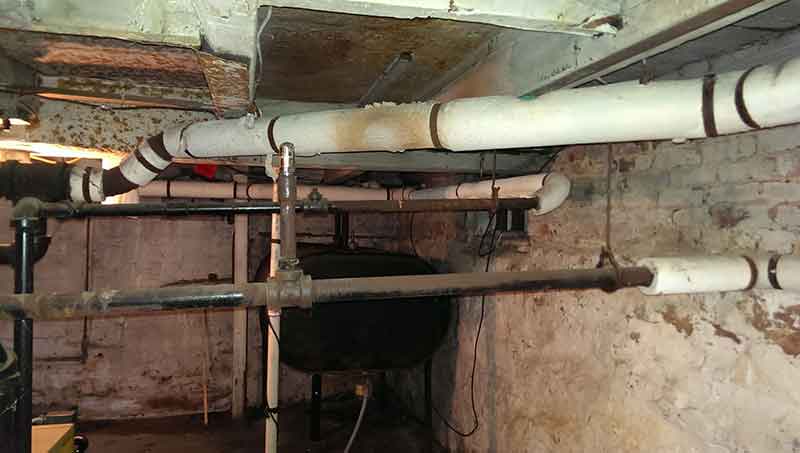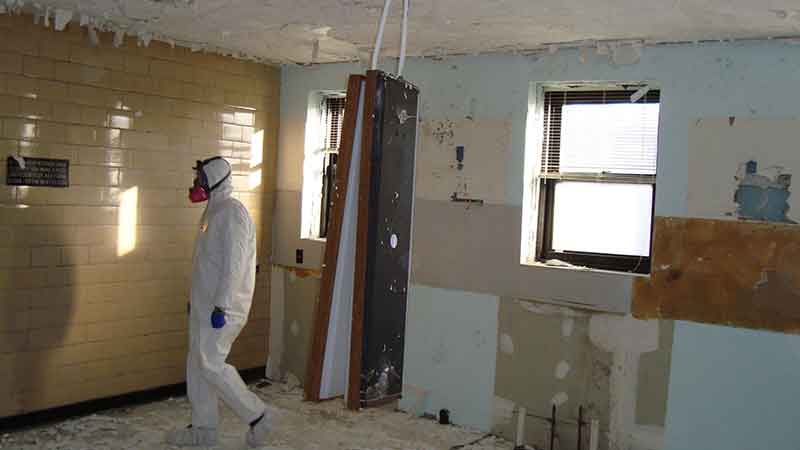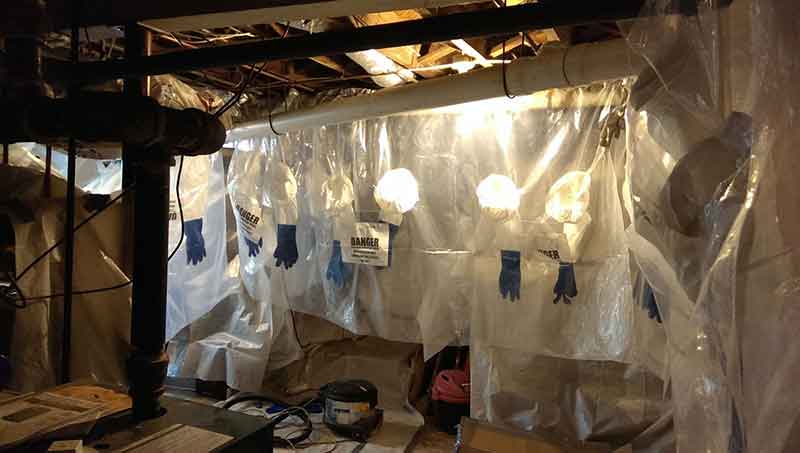Asbestos is a collective name for several naturally occurring minerals which have been mined from the ground for use in industry. Since it is well documented that exposure to asbestos can cause a variety of serious health effects, public awareness is very important. Asbestos containing products are still quite common in the international marketplace, and you can find products with “Fiber Containing Materials” for sale in local hardware and building supply stores throughout the US.
Dangerous levels of asbestos can be found in many buildings, and therefore most states currently require an asbestos inspection prior to demolition, removal, or renovations.
How do you test for asbestos?
The EPA recommends that materials suspected to contain asbestos be sampled by a properly trained and accredited asbestos professional (inspector). The professional then should use a qualified laboratory to perform the asbestos analysis. Since asbestos fibers are microscopic and pose a serious danger to human health when inhaled, proper precautions must be taken when sampling to avoid disturbing the fibers and making them airborne. If you are collecting the sample yourself (not recommended), be sure to use extreme caution.
How much does it cost to test for asbestos?
The cost to test for asbestos will vary from lab to lab, but generally speaking you can expect to pay in the range of $10 – $50 per sample for asbestos analysis. There are a wide variety of tests that run up to $200-$300 per sample, but your typical, basic pricing should be under $30 per sample. If you hire an Air Quality Professional to inspect an entire area for asbestos, collect samples from various suspect materials, and have them tested, depending on the size of the area, you can expect to pay between $500 to a few thousand dollars.
How long does it take to get my asbestos lab testing results?
Testing a material for asbestos will vary from lab to lab, but you can typically expect asbestos lab test results to take one to two weeks. Rush analysis is often available for additional fees.
Can you test for asbestos in the air?
Yes you can test for asbestos in the air, soil, water, as well as within construction materials and dust. Asbestos in air is a concern because microscopic asbestos fibers may float around and remain circulated in an occupied space via the HVAC system, fans, and general room traffic which can stir up fibers settled as dust. Testing for asbestos in air is usually done by either PCM (phase contrast microscopy) or TEM (transmission electron microscopy). TEM is considered the more accurate method because while PCM identifies if there are fibers in the air and at what concentrations, TEM can distinguish between the types of fibers and identify those that are asbestos. A Certified Asbestos Consultant will use their best judgement on whether you need an air test and how to proceed.
Can air purifiers remove asbestos?
Technically, yes, some high quality air purifiers can remove asbestos particles from the air, and Indoor Air Professionals use industrial sized air purifying units as part of their asbestos abatement protocol. However, airborne asbestos is extremely hazardous to your health, and if you suspect there are asbestos fibers in your occupied space, we highly recommend having a specialist inspect, test, remediate and clear the area for human occupation, rather than using an air purifier that has not been rated and verified for such use.
Do asbestos “Home Testing Kits” work?
In general, we do not recommend “do it yourself” kits for Indoor Air Quality issues. Home testing kits for asbestos are available in stores, usually for about $15 – $30. The kits contain sample collection bags, disposable gloves, and maybe an envelope for you to mail out your samples to their lab for an additional fee. If you don’t know what you are doing or how to take the proper precautions, you could put yourself and others at risk by disturbing the asbestos containing materials.
Can you live in a house with asbestos?
Believe it or not, yes you can live in a building that contains asbestos, as long as the asbestos containing material is intact. According to the EPA, asbestos containing materials are generally considered safe if they’re in good condition and not showing signs of wear and tear. The major concerns with asbestos begins when it becomes airborne and can enter the lungs, so unless the building is in major disrepair, and/or there are construction and renovation activities happening, you are often be better off leaving the asbestos alone and intact. Sealing or covering the asbestos material in question is also an option, but you should hire a professional for these services as there are protocols, procedures and safety issues to consider.
What does asbestos smell like?
Whether in bulk form or microscopic dust, asbestos has no smell or identifying odor.
What color is asbestos?
You may have heard terms like “blue asbestos” or “white asbestos.” But unless you are looking at the fibers under a microscope, you cannot identify asbestos by color. There are 6 types of asbestos: Chrysotile (usually white), Amosite (usually brown), Crocidolite (usually blue), Tremolite (color varies), Actinolite (usually dark green), and Anthophyllite (color varies). The 2 most common types of asbestos are Chrysotile and Amosite.
What does asbestos flooring look like?
The average person cannot tell whether a material contains asbestos simply by looking at it, unless it is labeled as such. Indoor Air Quality Professionals are very good at identifying asbestos containing materials because they have the training and experience to do so. But for the layperson, you can suspect that your flooring and other building materials could contain asbestos if the structure was built before 1980. Adding asbestos to flooring materials made them stronger and heat resistant, and asbestos was used extensively in most of the vinyl floor tiles that were so popular in the mid-1900s. The black mastic used to glue tiles down is also known to contain asbestos. To be certain that your flooring does, or does not, contain asbestos, you need to have it tested by a certified laboratory.
What does asbestos look like in walls and ceilings?
The average person cannot tell whether a material contains asbestos simply by looking at it, unless it is labeled as such. Asbestos was commonly added to drywall joint compound, wall paneling mastic, vinyl wallpaper, vinyl tiles and “popcorn ceilings,” in homes built before 1980, so if you have an older home, your walls, ceilings and floors may contain asbestos. They only way to be certain whether or not a given material contains asbestos is to have it tested by a certified laboratory.
How common is asbestos in drywall?
Asbestos was used in some types of drywall in the mid to late 1900s, but is more likely to be found in the heavier, insulated cement boards that were used as firewalls during that time. The joint compound (or drywall “mud”) however, is much more likely to contain asbestos. But even then, the asbestos does not pose a serious health risk unless it is disturbed and becomes airborne. That is why General Contractors as well as Weekend Warriors should always do a hazardous materials assessment before beginning any renovation project, especially on homes built before 1980.
When did builders stop using materials containing asbestos?
Believe it or not, asbestos still is not banned completely in the United States, and you can find asbestos containing products on the shelves of many hardware stores. The dangers of asbestos exposure on human health became known in the 1900s, and with The Clean Air Act of 1970, Congress identified asbestos as a hazardous air pollutant.
Without laws banning its use, however, builders continued to use asbestos containing materials in buildings and construction because of their appealing properties (increased durability, heat resistance, affordability, etc.) throughout the 1970s. It is estimated that more than 30 million tons of asbestos was used between 1900 and 1980. But in general, American builders phased out the use of products known to contain asbestos beginning in the late 1970s, as the connection between asbestos and lung disease could no longer be ignored. For a thorough look at asbestos laws and regulations in the US, visit the EPA’s asbestos page.
Banned Uses of Asbestos
- Corrugated paper
- Rollboard
- Commercial paper
- Specialty paper
- Flooring felt
- New uses of asbestos after 1989
Asbestos Uses NOT Banned in the US
- Asbestos-cement corrugated sheet
- Asbestos-cement flat sheet
- Asbestos clothing
- Pipeline wrap
- Roofing felt
- Vinyl-asbestos floor tile
- Asbestos-cement shingle
- Millboard
- Asbestos-cement pipe
- Automatic transmission components
- Clutch facings
- Friction materials
- Disc brake pads
- Drum brake linings
- Brake blocks
- Gaskets
- Non-roofing coatings
- Roof coatings
Where is asbestos most commonly found?
Historically, asbestos has been used in construction materials, insulation, fire retardants, “friction products” (automobile clutch, brake, and transmission parts), as well as heat-resistant fabrics, packaging, gaskets, and coatings.
We are often called upon to perform asbestos detection services for the following items:
- Attic and wall insulation produced containing vermiculite
- Ceiling tiles
- Floor tiles (and the backing on vinyl sheet flooring and adhesives)
- Roofing and siding shingles
- Textured paint and patching compounds used on wall and ceilings
- Walls and floors around wood-burning stoves protected with asbestos paper, millboard, or cement sheets
- Hot water & steam pipes coated with asbestos material or covered with an asbestos blanket or tape
- Oil and coal furnaces and door gaskets with asbestos insulation

Do Not Disturb! Asbestos can hide in many places! Call a professional.
Common Sources of Asbestos in Buildings
Historically, asbestos has been used in construction materials, insulation, fire retardants, “friction products” (automobile clutch, brake, and transmission parts), as well as heat-resistant fabrics, packaging, gaskets, and coatings. At ARA, we are often called upon to perform asbestos detection services for the following items:
- Attic and wall insulation produced containing vermiculite
- Ceiling tiles
- Floor tiles (and the backing on vinyl sheet flooring and adhesives)
- Roofing and siding shingles
- Textured paint and patching compounds used on wall and ceilings
- Walls and floors around wood-burning stoves protected with asbestos paper, millboard, or cement sheets
- Hot water and steam pipes coated with asbestos material or covered with an asbestos blanket or tape
- Oil and coal furnaces and door gaskets with asbestos insulation
Asbestos Experts at ARA
The Asbestos Inspectors, Monitors, Supervisors and Professional IAQ Consultants at Absolute Resource Associates have vast experience in providing safe and effective asbestos services. Because of the health risks, asbestos detection, sampling, testing and removal (abatement) should only be performed by Indoor Environmental Professionals (IEPs). Our highly trained IEPs at ARA know the laws, and we know what the best practices are to keep our clients (and our employees!) safe from asbestos exposure. We are licensed to perform asbestos detection, sampling, asbestos consulting services, as well as asbestos project design. Our clients include schools, government agencies, municipalities, US Military, commercial & industrial clients, homeowners and more.
The IAQ Team at ARA is certified to provide the following asbestos services:
- We perform a comprehensive survey and inspection of buildings for asbestos.
- Industry protocol is utilized for asbestos detection, identification and/or sampling. This includes known and suspected asbestos contaminated materials (ACM).
- Materials collected during our asbestos sampling are sent to an NVLAP (National Voluntary Laboratory Accreditation Program) accredited laboratory for analysis.
- We provide a detailed report of our inspection and all findings.
- We perform asbestos air monitoring upon request.
- Asbestos clearance testing is recommended after abatement.
We have these licensed professionals on staff:
- Asbestos Inspector
- Asbestos Consultant
- Asbestos Monitor
The EPA enacted the Federal Asbestos Hazard Emergency Response Act (AHERA) in 1986. Be aware however that asbestos laws may vary from state to state. For more information on asbestos regulation in New England, visit the following links:
- NH Asbestos Regulation
- MA Asbestos Regulation
- VT Asbestos Regulation
- ME Asbestos Regulation
- RI Asbestos Regulation
If you have a project or questions related to asbestos inspection, detection, testing, asbestos clearance testing or air monitoring, please give us a call today.

ARA IAQ professionals follow all safety protocols & regulations on each and every project, for your safety, and ours!

